Aerodynamics - For Kids
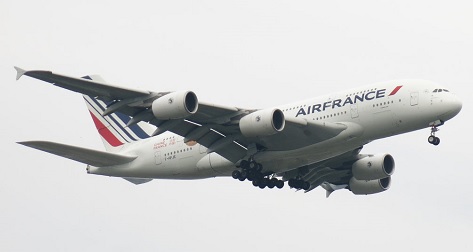
Airbus A380. Source: http://en.wikipedia.org/wiki/Airbus_A380. Author: http://commons.wikimedia.org/wiki/User:AEMoreira042281
Aerodynamics is the branch of physics that deals with the dynamics of air as it interacts with solid objects, such as airplane wings. Anything that flies, such as airplanes, helicopters, and birds, utilize the principles of aerodynamics to move through the air.
Airplanes and helicopters are designed and created by people, while birds (and other flying animals such as bats and insects) owe their flying ability to evolution. But both are fascinating in their own right.
Airplanes are able to fly because of two key effects. The first effect is the "push" given by the airplane engines which propel the airplane through the air. The second effect is the movement of air over the airplane's wings which creates the lifting force required to keep the airplane up in the air. In simple terms, the wings of an airplane generate lift force and the engine creates the thrust to propel the airplane through the air.
Now, for birds and other flying animals, the flapping motion of their wings create both lift and thrust. If the wings of an airplane could flap they would also propel the airplane through the air and maintain lift, and an engine wouldn't be needed. But it would be very difficult to design and build an airplane with flapping wings. It would be an extreme engineering challenge which is why airplanes are designed to keep the source of lift (the wings) and thrust (the engine) separate.
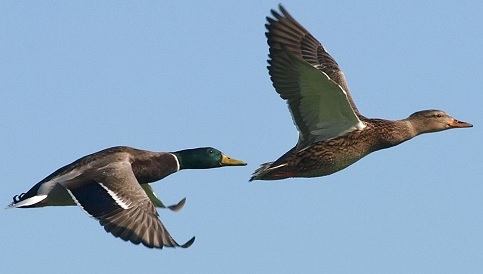
Source: http://commons.wikimedia.org/wiki/File:Mallard_pair_in_flight.jpg. Author: Ingrid Taylar
To gain an understanding of the aerodynamic forces necessary for flight consider the figure below showing an airplane flying through the air.
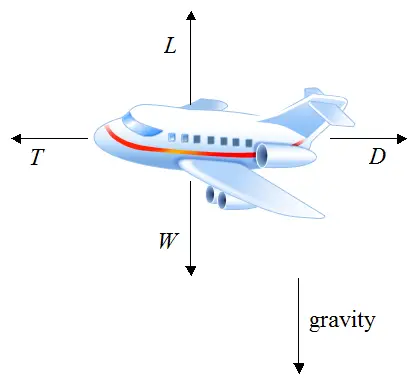
If the airplane is moving at constant velocity with no acceleration, the forces shown in the figure must balance. This means that the lift force (L) generated by the airplane wings must equal the airplane weight (W) due to gravity. Similarly, the thrust force (T) generated by the airplane engines must equal the drag force (D) caused by air resistance.
Wings are also called airfoils and the shape of their cross-section determines how well the air flows over the wing to generate lift. The presence of air friction (viscosity) is what allows an airfoil to generate lift. The reasoning behind this is complicated but basically, the air flow pattern around an airfoil results in the lower half of the airfoil experiencing greater pressure force than the top half of the airfoil. As a result, a lift force is generated. The figure below shows the cross-section view of an airfoil.
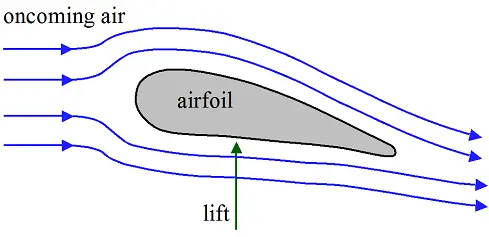
Airplanes and flying animals, such as birds, have streamlined shapes. This means that they fly through the air with minimal drag (also known as air resistance). This is desirable since it means that it takes less energy to fly through the air. In the case of an airplane this means that fuel consumption is minimized. But drag can only be reduced, and never eliminated. To gain a feel for what is meant by drag consider the figure below showing a ball thrown with air drag present and with no air drag present.
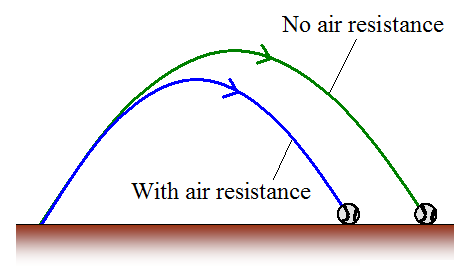
As shown, the ball thrown with no air resistance flies farther than the ball with air resistance. However, only a perfect vacuum can result in no air resistance since there would be no air molecules hitting against the object as it moves, which would slow it down.
Helicopters (shown below) are another type of flying machine made by people. Just like airplanes, helicopters also rely on aerodynamic principles to fly. The main rotor of a helicopter consists of several blades. Each blade acts as a type of wing, and when the rotor rotates the air flows past the blade and generates a lift force to keep the helicopter in the air. The spinning tail rotor works on the same principle as the main rotor. It provides a counter "push" force to prevent the helicopter from spinning in a direction opposite to the direction of rotation of the main rotor.
The thrust comes from tilting the main rotor. To move the helicopter forward the main rotor is tilted forward a bit, which creates a horizontal force to propel the helicopter forward. Similarly, to move the helicopter sideways the main rotor is tilted sideways a bit in the direction the pilot wants to go (either left or right).
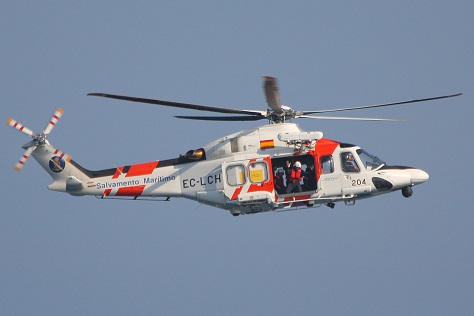
Source: http://commons.wikimedia.org/wiki/File:AW-139_SASEMAR.jpg. Author: Jordi Payà
Helicopters have a big advantage over airplanes in that they can hover in one spot and move sideways or vertically. This makes them very useful for certain tasks, such as rescue missions. Airplanes must move forward at high speed in order to generate air flow over the wings to generate lift force. But helicopters can remain stationary in the air and generate lift force with the air flow over the rotating main rotor blades.
Another good demonstration of aerodynamics is paper airplanes. Every kid has thrown one. So the next time you throw a paper airplane know that there is aerodynamics at work, and the better the aerodynamic design of your paper airplane the farther and straighter it will fly.
Here are some fun toys that demonstrate some of the principles of aerodynamics: balsa glider, boomerang, and tim bird.
Return to Physics For Kids page
Return to Real World Physics Problems home page
Free Newsletter
Subscribe to my free newsletter below. In it I explore physics ideas that seem like science fiction but could become reality in the distant future. I develop these ideas with the help of AI. I will send it out a few times a month.